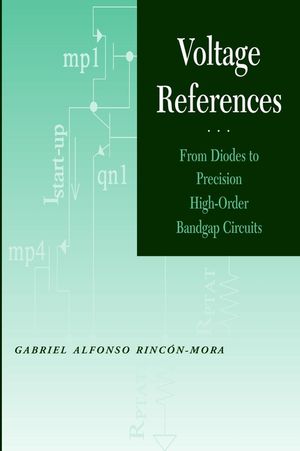Voltage References: From Diodes to Precision High-Order Bandgap CircuitsISBN: 978-0-471-14336-9
Paperback
192 pages
October 2001, Wiley-IEEE Press
 This is a Print-on-Demand title. It will be printed specifically to fill your order. Please allow an additional 10-15 days delivery time. The book is not returnable.
|
||||||
PREFACE xi
ACKNOWLEDGMENTS xlii
LIST OF TABLES xv
LIST OF FIGURES xvii
SUMMARY xxi
1 THE BASICS 1
1.1 The Diode 4
1.1.1 Breakdown Region 6
1.1.2 Forward-Biased Region 7
1.2 Current Mirrors 8
1.2.1 The Simple Mirror 10
1.2.2 Cascode Mirrors 11
1.2.3 Regulated Cascode Mirrors 13
1.3 Summary 16
Appendix A.I Temperature Dependence of the Diode Voltage 16
Bibliography 20
2 CURRENT REFERENCES 23
2.1 PTAT Current References 24
2.1.1 Bipolar Implementations 24
2.1.2 CMOS Implementations 26
2.2 Startup Circuits and Frequency Compensation 29
2.2.1 Continuous-Conduction Startup Circuits 29
2.2.2 State-Dependent Startup Circuits 30
2.2.3 Frequency Compensation 33
2.3 CTAT Current References 34
2.4 Temperature-Independent Current References 35
2.5 PTAT2 Current Generators 36
2.5.1 Bipolar Implementations 36
2.5.2 CMOS Implementations 37
2.6 Summary 42
Bibliography 43
3 VOLTAGE REFERENCES 45
3.1 Zero-Order References 46
3.1.1 Forward-Biased Diode References 46
3.1.2 Zener References 50
3.2 First-Order References 50
3.2.1 Forward-Biased Diode References 50
3.2.2 Zener References 53
3.3 Second-Order References (Curvature Correction) 57
3.4 State-of-the-Art Curvature-Correction Techniques 61
3.4.1 Temperature-Dependent Resistor Ratio 61
3.4.2 Diode Loop 62
3.4.3 j8 Compensation 64
3.4.4 Piecewise-Linear Current-Mode Technique 65
3.4.5 Matched-Nonlinear Correction 67
3.4.6 Exact Method 71
3.5 Summary 76
Bibliography 77
4 DESIGNING PRECISION REFERENCE CIRCUITS 79
4.1 Error Sources 80
4.1.1 Qualitative Effects 81
4.2 The Output Stage 87
4.2.1 Voltage-Mode 88
4.2.2 Current-Mode 89
4.2.3 Mixed-Mode 90
4.2.4 Regulated versus Unregulated References 91
4.3 Designing for Power Supply Rejection and Line Regulation 99
4.3.1 Cascodes 99
4.3.2 Pseudo-Power Supply 101
4.4 Summary 108
Appendix A.4 Error Sources in a Typical First-Order Bandgap 108
Appendix B.4 Effect of the Resistors' Temperature Coefficient on a Reference with a Current-Mode Output Stage 116
Bibliography 118
5 CONSIDERING THE SYSTEM AND THE WORKING ENVIRONMENT 119
5.1 Design of the Trim Network 120
5.1.1 Trim Range 121
5.1.2 Trimming Techniques 124
5.2 Package-Shift Effects 130
5.3 System-Related Issues 134
5.3.1 Circuit Implications 134
5.3.2 Layout Implications 135
5.4 Characterization 138
5.5 Summary 142
Appendix A.5 Bandgap Trimming Procedure for a Mixed-Mode (Both Voltage-Mode and Current-Mode) Output Stage 143
Appendix B.5 Package Shift-Effects in Bandgap Reference Circuits 148
Appendix C.5 Derivation of the Time Required for a Reference Circuit to Change a Finite Amount upon a Single-Step Stimulus 153
Bibliography 155
INDEX 157
ABOUT THE AUTHOR 167



